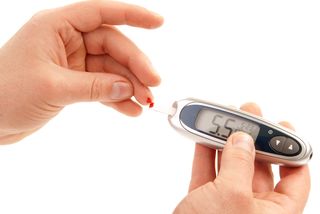Half of American Adults Have Diabetes or Prediabetes

About half of American adults have either diabetes or prediabetes, a new study says.
In 2011 to 2012, more than 12 percent of U.S. adults had diabetes, and 38 percent had prediabetes, a condition in which blood sugar levels are abnormally high, the study found.
In addition, more than one-third of people with diabetes were undiagnosed, meaning they didn't know they had the condition. The percentage of people with undiagnosed diabetes was particularly high among Asian Americans — about 50 percent of Asian Americans with diabetes were not aware they had the condition, according to the study.
"By learning more about who has diabetes — and who has the disease but does not know it — we can better target research and prevention efforts," Dr. Griffin Rodgers, director of the National Institute of Diabetes and Digestive and Kidney Diseases (NIDDK), said in a statement. "We have treatments to help people with diabetes, but treatments can only help those who have been diagnosed." [5 Diets That Fight Diseases]
Diabetes is a major cause of death in the United States, the researchers said. The condition also increases people's risk of heart disease and stroke and, if left untreated, can cause complications including nerve damage, kidney failure and blindness. Most cases of diabetes are type 2, in which the body's cells stop responding to the hormone insulin, which results in a buildup of sugar in the bloodstream.
In the new study, the researchers analyzed information from more than 26,000 U.S. adults who took part in surveys between 1988 and 2012. Participants were asked whether they had ever been diagnosed with diabetes, and they also gave blood samples so that the researchers could check the participants' blood sugar levels.
During the study period, the percentage of people with diabetes increased from less than 10 percent in the 1988-1994 period, to more than 12 percent in 2011-2012. This rise in diabetes parallels an increase in obesity — the most important risk factor for type 2 diabetes, the researchers said.
Sign up for the Live Science daily newsletter now
Get the world’s most fascinating discoveries delivered straight to your inbox.
However, the prevalence of diabetes changed little between 2007 and 2012, which may reflect a leveling of obesity rates that occurred around the same time, the researchers noted.
Diabetes was most common among older adults — about one in three adults age 65 and over had the condition in 2011-2012, compared to 17 percent of adults ages 45 to 64, and 5 percent of adults younger than 45.
About one-third of whites with diabetes (32 percent) did not know they had the condition, compared to 37 percent of blacks, 49 percent of Hispanics and 51 percent of Asian Americans.
One reason for the high percentage of undiagnosed diabetes among Asian Americans may be that people in this ethnic group often develop type 2 diabetes at a lower body mass index (BMI) than people of other ethnic groups. This means that doctors may not screen Asian Americans for diabetes when, in fact, they could be at risk for the disease, the researchers said.
"The large proportion of people with undiagnosed diabetes points to both a greater need to test for type 2 diabetes and a need for more education on when to test for type 2 diabetes, especially since populations such as Asian Americans may develop type 2 at a lower body mass than other groups," study co-author Catherine Cowie, director of diabetes epidemiology programs at NIDDK, said in a statement.
The researchers hope that future studies will provide more information about which subgroups of people are at highest risk for underdiagnoses.
The researchers noted that the American Diabetes Association recommends that people have two tests to confirm a diagnosis of diabetes. But in the new study, the researchers often had information from just one blood test. This means that some participants may have been classified as having diabetes when they didn't have the condition, the researchers said.
The study is published in the Sept. 8 issue of the Journal of the American Medical Association.
Follow Rachael Rettner @RachaelRettner. Follow Live Science @livescience, Facebook & Google+. Original article on Live Science.

Rachael is a Live Science contributor, and was a former channel editor and senior writer for Live Science between 2010 and 2022. She has a master's degree in journalism from New York University's Science, Health and Environmental Reporting Program. She also holds a B.S. in molecular biology and an M.S. in biology from the University of California, San Diego. Her work has appeared in Scienceline, The Washington Post and Scientific American.